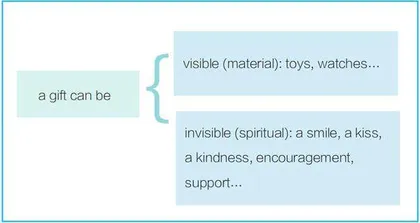以思维活动为语言学习支架的实践探索
作者: 陈晓云

引言
自新一轮基础教育课程改革启动以来,在英语教学中发展学生思维品质的重要性已在广大英语教师中形成共识。《义务教育英语课程标准(2022年版)》在英语课程总目标中明确提出提升思维品质,指出学生通过英语课程学习,“能够在语言学习中发展思维,在思维发展中推进语言学习;初步从多角度观察和认识世界、看待事物,有理有据、有条理地表达观点;逐步发展逻辑思维、辩证思维和创新思维,使思维体现一定的敏捷性、灵活性、创造性、批判性和深刻性”(教育部,2022:6)。
在课程标准的引领下,培养学生思维品质的探索在英语教学中广泛开展。然而,在此过程中也出现了“为发展思维品质而发展思维品质”的现象,致使思维活动与其他活动,尤其是基础性的语言学习活动相割裂。笔者观摩学习的很多课例基本都有不同层次、不同成效的思维活动,但与语言学习有效融合的却为数不多。而笔者发现,更为有效的英语学习活动,无论是专项学习活动还是综合学习活动(陈晓云,2017a),应是融合或整合各种要素学习的活动(鲁子问等,2017)。因此,笔者尝试以思维活动为语言学习支架,促进思维品质和语言能力的融合发展。本文将基于笔者的教学实践案例,具体阐释并分析教学思路。
以思维活动为语言学习支架的阅读教学实践
在英语阅读教学实践中,笔者一直关注学生思维品质和语言能力的同步发展(陈晓云,2017b;2017c)。下面笔者以一个故事教学为例,具体阐述如何以思维活动搭建语言学习支架。该案例所使用的的教学材料为笔者参与撰写的英语分级读物Making a Needle from an Iron Rod(《磨杵成针》),讲述了少年时代的诗人李白被一位老妇人磨杵成针的精神所激励的故事。在教学中,笔者通过搭建思维支架,帮助学生深度理解故事,学习is、may be、can be等词汇和短语的意义,发展辩证看待问题、解决问题的思维能力。以下展示三个具体教学片段。
[片段1 ]
读前环节,笔者首先帮助学生理解文本标题。笔者在课件上呈现英文标题,并提问:“What is the Chinese title of this story?”
师生对话片段如下:
S1: 磨杵成针.
T: How do you know?
S1: I know the words “iron” and “needle”. They are “铁” and “针” in Chinese. From the part “into a needle (成为针)”,I think the Chinese title is “磨杵成针”.
T: You just used the word “is”. We know the word “is” means you are sure about what you said. Are you sure about it? How sure are you?
(S1此时迟疑了)
T: Your answer is just from some expressions you know. You still don’t know “grind” and “rod”. So you are not 100 percent sure.
S2: I just checked my dictionary, “grind” means “磨” and “rod” means “棒”. So I am very much sure about it.
T: What dictionary?
S2: Oxford.
T: Oh, it is an authoritative reference. So, we are now 100 percent sure by knowing the meanings of “grind” “iron” “rod” and “needle”.
通过以上讨论,学生认识到判断语义时不能仅仅依赖只言片语,而要基于已知词义并借助词典等工具来进行深入理解。笔者在教学中经常采用这种分析方法引导学生准确辨析词义,理解语义内涵,帮助学生在夯实语言知识的同时发展逻辑思维。
[片段2 ]
在接下来的教学中,笔者继续开展以思维为支架的语言学习活动。在学生理解标题含义后,笔者请学生讲述他们在语文课上所学的关于“磨杵成针”的故事,然后提问:“Do you think it is a true story?”
师生对话片段如下:
Ss: No.
T: How do you know it’s untrue?
S3: Nobody makes a needle by grinding an iron rod.
T: Are you sure?
S4: Yes. I once read Tiangong Kaiwu (《天工开物》) and got to know the way of making needles.
T: When was the book Tiangong Kaiwu written? Before or after the time of Li Bai?
S4: In the Ming Dynasty. After Li Bai’s time.
T: So it is not evidence for your statement.
S5: I once saw some needles at the Hubei Provincial Museum. People made those needles over 2000 years ago.
笔者请一位学生立即用电子白板上网搜索相关资料并进行展示。学生们看到了湖北省博物馆展出的春秋战国时期的针,还了解到早在那时的中国人就已经掌握了捶打金属制作针的技艺。于是,笔者启发学生进一步思考故事的内涵。
T: So, we are sure that grinding an iron rod into a needle in ancient times is untrue. Does it mean that the story is also untrue?
S6: Maybe the story is true, but the old lady’s purpose is not to make a needle. Maybe she did this to teach Li Bai a lesson.
T: Why “maybe”? What is the difference between “maybe” and “is”? Just now we said “is” is for 100 percent sure. Then how much certainty can we express through “maybe” or “may be”?
S7: I think “may be” is for something we are not sure about.
T: So, the story may be true. The purpose of the old lady’s grinding an iron rod may not be making a needle, but to teach Li Bai a lesson. Do you all agree?
Ss: Yes.
T: Can we also say “The story can be true”?
S8: I am not sure.
S9: I think we can.
T: What’s the difference between “can be true” and “may be true”?
学生无法回答这个问题,因此笔者让学生查阅语法书并带领他们得出结论:When we believe it is logically true, we say “it can be true”. When we believe it is possibly true, we say “it may be true”. When we are not sure about something, but we think it is possible, we can use “maybe” or “may be”. When we are not sure about something but it is logical, we can use “can be”.
笔者在上述讨论中为学生搭建了一系列思维支架,逐步深化了学生对is、maybe、may be、can be的理解。对于这类讨论,笔者通常不直接在课堂上给出“准确、唯一”的答案,而是鼓励学生课后进一步探索,深入理解并运用所学词汇和语法知识,进而判断相关讨论是否准确。在进行单元复习时,笔者还会有针对性地引导学生总结归纳本单元的语言知识,完成相应的巩固练习。这一方式有助于引导学生拓宽思维路径,学会结合证据,进行丰富、多样、有逻辑的思考与讨论,从而发展批判性与创造性思维能力。
[片段3 ]
在阅读过程中,笔者引导学生分析文中李白和父母的矛盾,找出相应语句。学生发现李白和父母对于写作的看法分歧是矛盾的焦点,李白认为“writing is hard and boring”。为引导学生探究是否有可能以及如何能调解李白和父母的矛盾,从而发展解决问题的意识和能力,笔者适时引导学生思考并讨论。师生对话片段如下:
T: What is the opposite of “hard and boring”?
S10: Easy and fun.
T: Can writing be easy?
S11: I don’t think so.
T: Then, can writing be fun?
S12: Yes, it can. We can do writing in a fun way.
T: So writing is hard, but we can try to make it fun. Part of Li Bai’s difficulties with writing can be solved.
在此基础上,笔者引导学生总结提炼:“When we have difficulties, if we can’t solve all the problems, we can try to solve part of them.”
最后,笔者用问题引导学生进一步讨论:“I believe everyone has some ‘needles’ to make in life. What is your ‘needle’ now? How do you make it? Grinding an iron rod into a needle or buying one directly?”
学生纷纷发表自己的观点,形成对needle、grind等核心词汇比喻意义的更丰富的认识,在深入学习语言知识的同时,深化对文本主题意义的理解。在此过程中,学生建立起辩证看待困难和灵活解决困难的意识,思维能力也得以强化。同时,他们的阅读理解能力,尤其是词义、语句、主题意义等理解与探究能力,也得到显著发展。可见,思维活动成为语言学习的有效支架。